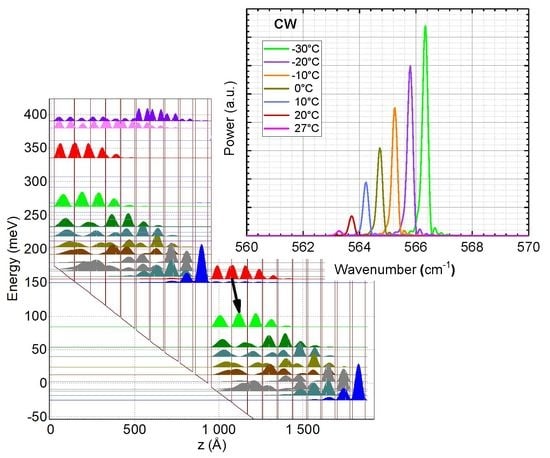Long Wavelength (λ > 17 µm) Distributed Feedback Quantum Cascade Lasers Operating in a Continuous Wave at Room Temperature
Abstract
1. Introduction
2. Materials and Methods
3. Results and Discussion
4. Conclusions
Author Contributions
Funding
Conflicts of Interest
References
- Vitiello, M.S.; Scalari, G.; Williams, B.; Natale, P.D. Quantum cascade lasers: 20 years of challenges. Opt. Express 2015, 23, 5167–5182. [Google Scholar] [CrossRef] [PubMed]
- Laffaille, P.; Moreno, J.C.; Teissier, R.; Bahriz, M.; Baranov, A.N. High temperature operation of short wavelength InAs-based quantum cascade lasers. AIP Adv. 2012, 2, 022119. [Google Scholar] [CrossRef]
- Bahriz, M.; Lollia, G.; Baranov, A.N.; Teissier, R. High temperature operation of far infrared (lambda approximate to 20 μm) InAs/AlSb quantum cascade lasers with dielectric waveguide. Opt. Express 2015, 23, 1523–1528. [Google Scholar] [CrossRef] [PubMed]
- Cathabard, O.; Teissier, R.; Devenson, J.; Moreno, J.C.; Baranov, A.N. Quantum cascade lasers emitting near 2.6 μm. Appl. Phys. Lett. 2010, 96, 141110. [Google Scholar] [CrossRef]
- Walther, C.; Scalari, G.; Faist, J.; Beere, H.; Ritchie, D. Low frequency terahertz quantum cascade laser operating from 1.6 to 1.8 THz. Appl. Phys. Lett. 2006, 89, 231121. [Google Scholar] [CrossRef]
- Faist, J.; Gmachl, C.; Capasso, F.; Sirtori, C.; Sivco, D.L.; Baillargeon, J.N.; Cho, A.Y. Distributed feedback quantum cascade lasers (vol 70, pg 2670, 1997). Appl. Phys. Lett. 1997, 71, 986. [Google Scholar] [CrossRef]
- Xie, F.; Caneau, C.; LeBlanc, H.P.; Coleman, S.; Hughes, L.C.; Zah, C. Continuous wave operation of distributed feedback quantum cascade lasers with low threshold voltage and low power consumption. In Novel in-Plane Semiconductor Lasers Xi; Belyanin, A.A., Smowton, P.M., Eds.; Spie-Int Soc Optical Engineering: Bellingham, WA, USA, 2012; Volume 8277, p. 82770S. ISBN 978-0-8194-8920-3. [Google Scholar]
- Lu, Q.Y.; Bai, Y.; Bandyopadhyay, N.; Slivken, S.; Razeghi, M. Room-temperature continuous wave operation of distributed feedback quantum cascade lasers with watt-level power output. Appl. Phys. Lett. 2010, 97, 231119. [Google Scholar] [CrossRef]
- Xie, F.; Caneau, C.; LeBlanc, H.P.; Coleman, S.; Ho, M.-T.; Hughes, L.C.; Zah, C. Room temperature continuous wave operation of long Wavelength (9–11 μm) distributed feedback quantum cascade lasers for glucose detection. In Novel in-Plane Semiconductor Lasers Xii; Belyanin, A.A., Smowton, P.M., Eds.; Spie-Int Soc Optical Engineering: Bellingham, WA, USA, 2013; Volume 8640, p. 864016. ISBN 978-0-8194-9409-2. [Google Scholar]
- Saeedi, K.; Szech, M.; Dluhy, P.; Salvail, J.Z.; Morse, K.J.; Riemann, H.; Abrosimov, N.V.; Nötzel, N.; Litvinenko, K.L.; Murdin, B.N.; et al. Optical pumping and readout of bismuth hyperfine states in silicon for atomic clock applications. Sci. Rep. 2015, 5, 10493. [Google Scholar] [CrossRef]
- Kajita, M. Precise Measurement of Transition Frequencies of Optically Trapped 40Ca19F Molecules. J. Phys. Soc. Jpn. 2018, 87, 104301. [Google Scholar] [CrossRef]
- Tokunaga, S.K.; Hendricks, R.J.; Tarbutt, M.R.; Darquié, B. High-resolution mid-infrared spectroscopy of buffer-gas-cooled methyltrioxorhenium molecules. New J. Phys. 2017, 19, 053006. [Google Scholar] [CrossRef]
- Tredicucci, A.; Gmachl, C.; Capasso, F.; Sivco, D.L.; Hutchinson, A.L.; Cho, A.Y. Long wavelength superlattice quantum cascade lasers at lambda similar or equal to 17 μm. Appl. Phys. Lett. 1999, 74, 638–640. [Google Scholar] [CrossRef]
- Huang, X.; Charles, W.O.; Gmachl, C. Temperature-insensitive long-wavelength (lambda approximate to 14 μm) Quantum Cascade lasers with low threshold. Opt. Express 2011, 19, 8297–8302. [Google Scholar] [CrossRef] [PubMed]
- Fujita, K.; Yamanishi, M.; Edamura, T.; Sugiyama, A.; Furuta, S. Extremely high T0-values (~450 K) of long-wavelength (~15 μm), low-threshold-current-density quantum-cascade lasers based on the indirect pump scheme. Appl. Phys. Lett. 2010, 97, 201109. [Google Scholar] [CrossRef]
- Ohtani, K.; Beck, M.; Süess, M.J.; Faist, J.; Andrews, A.M.; Zederbauer, T.; Detz, H.; Schrenk, W.; Strasser, G. Far-Infrared Quantum Cascade Lasers Operating in the AlAs Phonon Reststrahlen Band. ACS Photonics 2016, 3, 2280–2284. [Google Scholar] [CrossRef]
- Rochat, M.; Hofstetter, D.; Beck, M.; Faist, J. Long-wavelength (lambda approximate to 16 μm), room-temperature, single-frequency quantum-cascade lasers based on a bound-to-continuum transition. Appl. Phys. Lett. 2001, 79, 4271–4273. [Google Scholar] [CrossRef]
- Fuchs, P.; Semmel, J.; Friedl, J.; Hoefling, S.; Koeth, J.; Worschech, L.; Forchel, A. Distributed feedback quantum cascade lasers at 13.8 μm on indium phosphide. Appl. Phys. Lett. 2011, 98, 211118. [Google Scholar] [CrossRef]
- Loghmari, Z.; Bahriz, M.; Thomas, D.D.; Meguekam, A.; Van, H.N.; Teissier, R.; Baranov, A.N. Room temperature continuous wave operation of InAs/AlSb-based quantum cascade laser at approximate to 11 μm. Electron. Lett. 2018, 54, 1045–1046. [Google Scholar] [CrossRef]
- Baranov, A.N.; Bahriz, M.; Teissier, R. Room temperature continuous wave operation of InAs-based quantum cascade lasers at 15 μm. Opt. Express 2016, 24, 18799–18806. [Google Scholar] [CrossRef] [PubMed]
- Loghmari, Z.; Bahriz, M.; Meguekam, A.; Teissier, R.; Baranov, A.N. InAs-based quantum cascade lasers emitting close to 25 μm. Electron. Lett. 2019, 55, 144–145. [Google Scholar] [CrossRef]
- Yu, J.S.; Slivken, S.; Darvish, S.R.; Evans, A.; Gokden, B.; Razeghi, M. High-power, room-temperature, and continuous-wave operation of distributed-feedback quantum-cascade lasers at lambda similar to 4.8 μm. Appl. Phys. Lett. 2005, 87, 041104. [Google Scholar] [CrossRef]
- Orfanos, I.; Sphicopoulos, T.; Tsigopoulos, A.; Caroubalos, C. A Tractable Above-Threshold Model for the Design of Dfb and Phase-Shifted Dfb Lasers. IEEE J. Quantum Electron. 1991, 27, 946–956. [Google Scholar] [CrossRef]
- Slivken, S.; Bandyopadhyay, N.; Tsao, S.; Nida, S.; Bai, Y.; Lu, Q.Y.; Razeghi, M. Sampled grating, distributed feedback quantum cascade lasers with broad tunability and continuous operation at room temperature. Appl. Phys. Lett. 2012, 100, 261112. [Google Scholar] [CrossRef]
- Wang, D.-B.; Zhang, J.-C.; Cheng, F.-M.; Zhao, Y.; Zhuo, N.; Zhai, S.-Q.; Wang, L.-J.; Liu, J.-Q.; Liu, S.-M.; Liu, F.-Q.; et al. Stable Single-Mode Operation of Distributed Feedback Quantum Cascade Laser by Optimized Reflectivity Facet Coatings. Nanoscale Res. Lett. 2018, 13, 37. [Google Scholar] [CrossRef] [PubMed]
- Carras, M.; Garcia, M.; Marcadet, X.; Parillaud, O.; De Rossi, A.; Bansropun, S. Top grating index-coupled distributed feedback quantum cascade lasers. Appl. Phys. Lett. 2008, 93, 011109. [Google Scholar] [CrossRef]
- Chastanet, D.; Bousseksou, A.; Lollia, G.; Bahriz, M.; Julien, F.H.; Baranov, A.N.; Teissier, R.; Colombelli, R. High temperature, single mode, long infrared (lambda = 17.8 μm) InAs-based quantum cascade lasers. Appl. Phys. Lett. 2014, 105, 111118. [Google Scholar] [CrossRef]
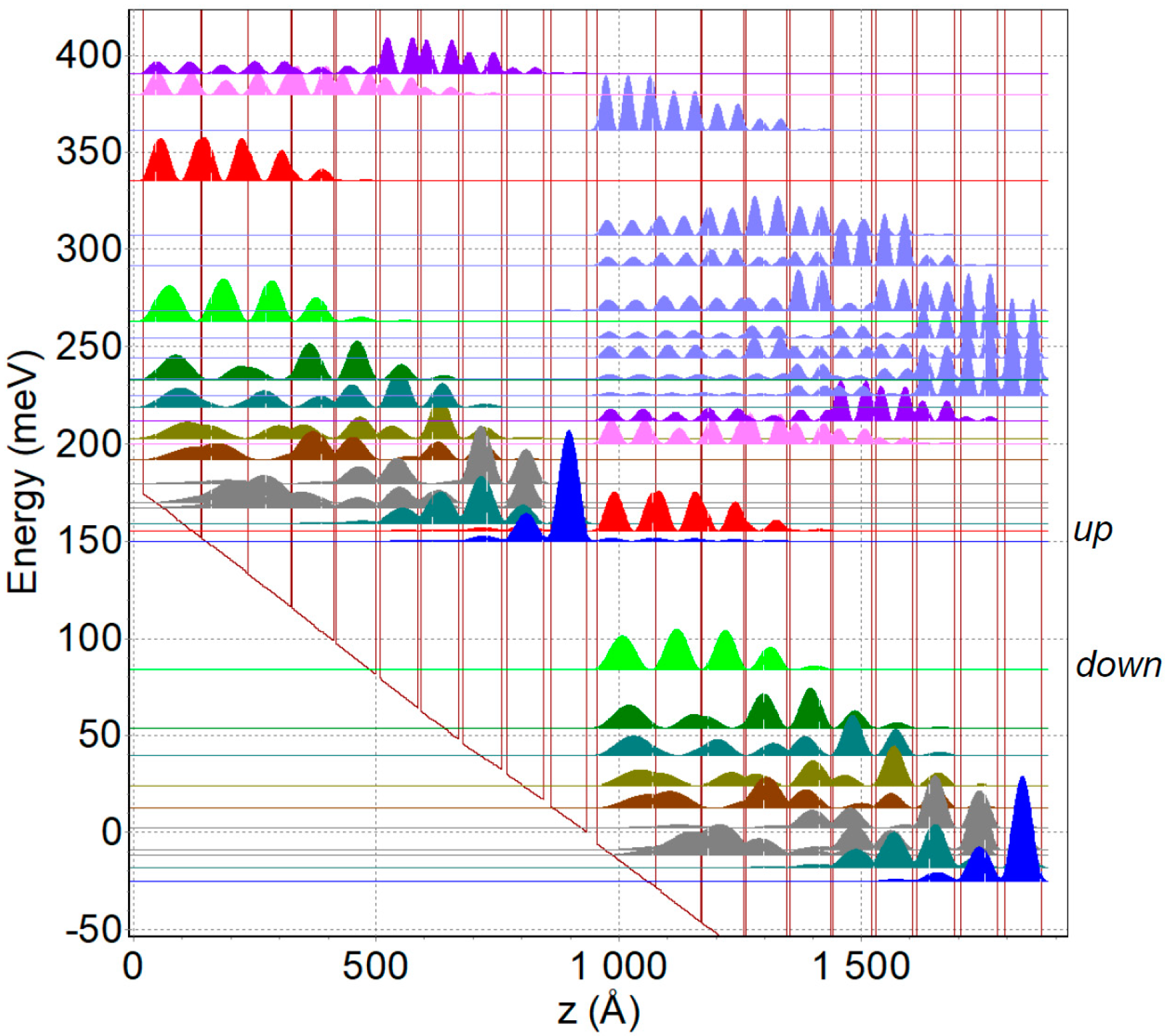
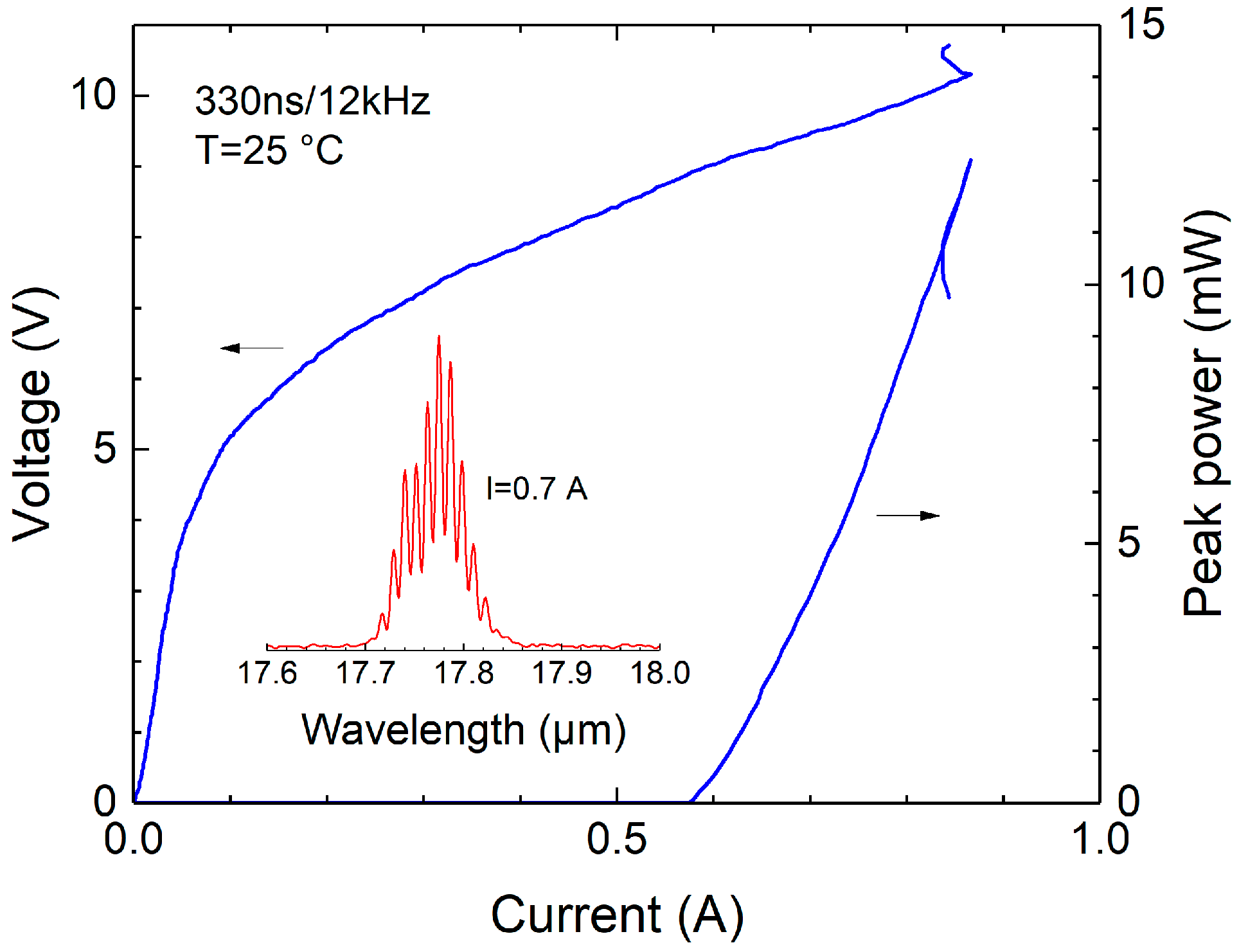
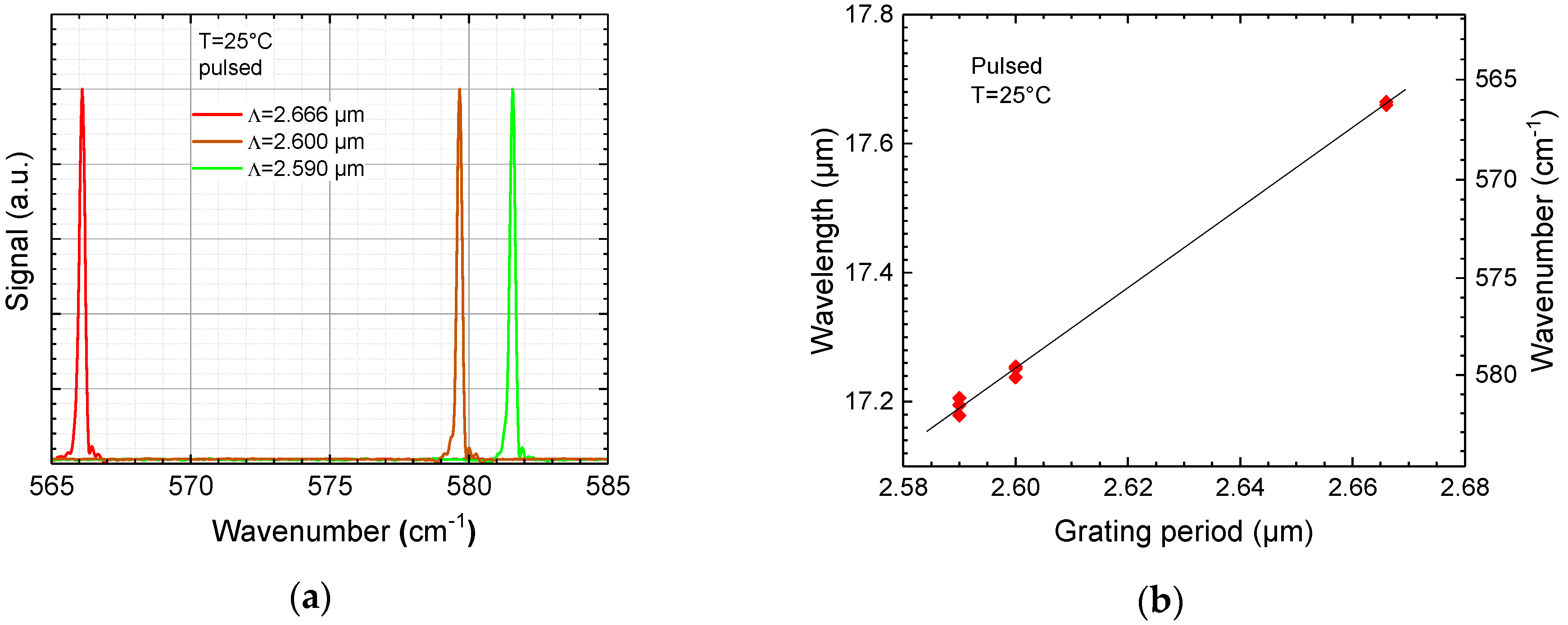
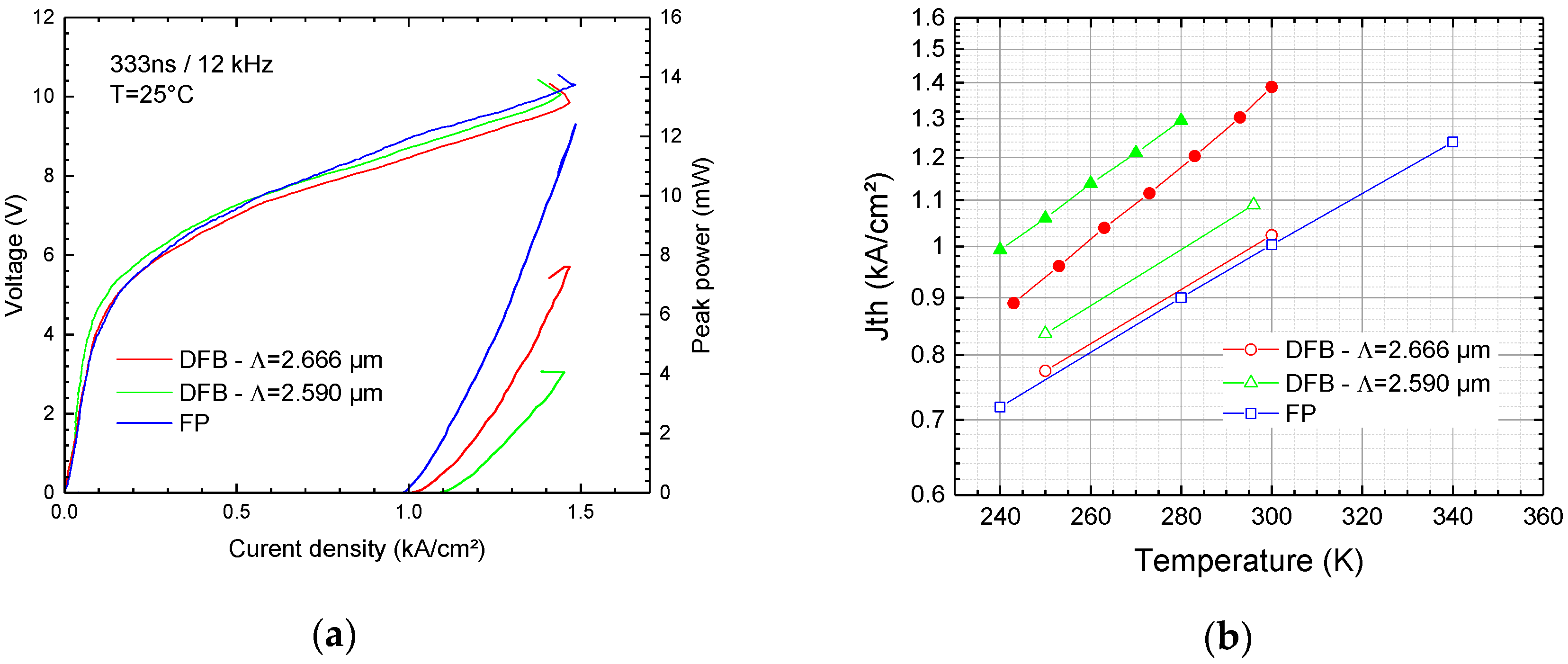
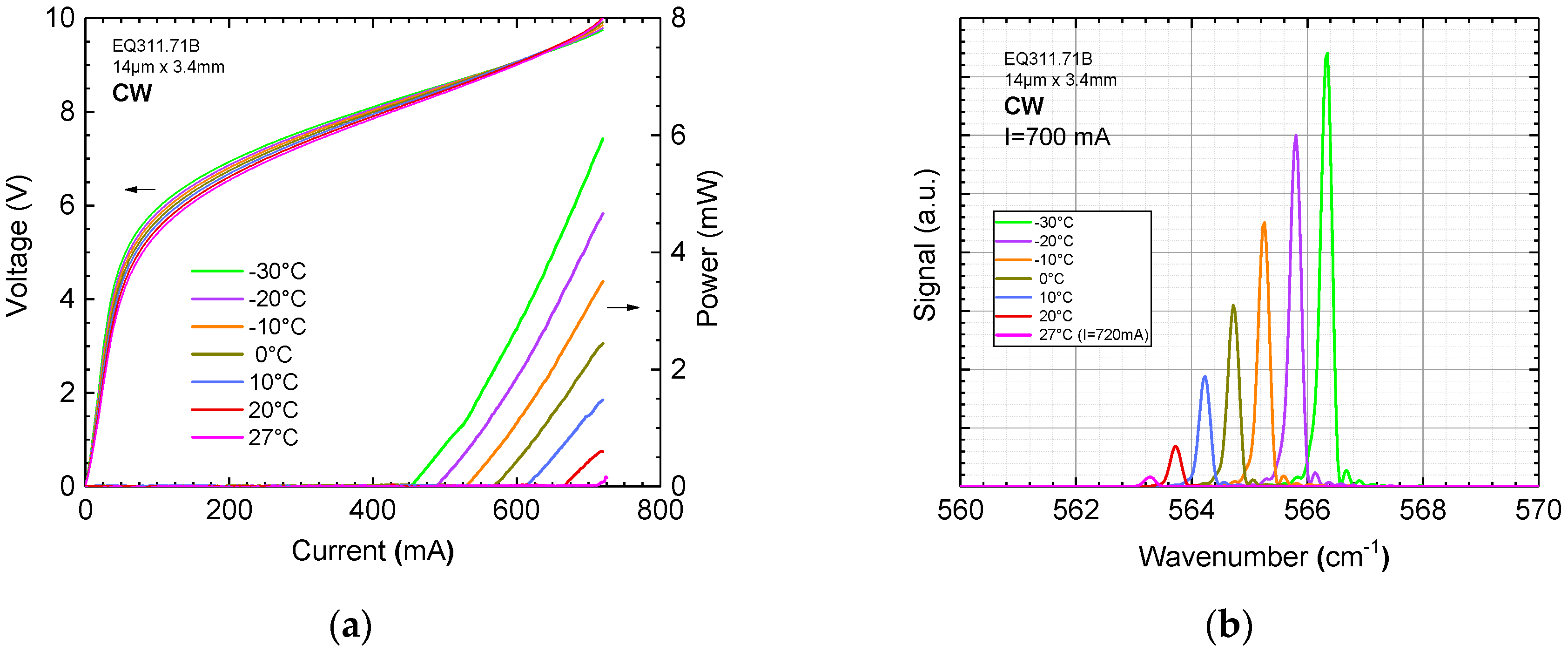
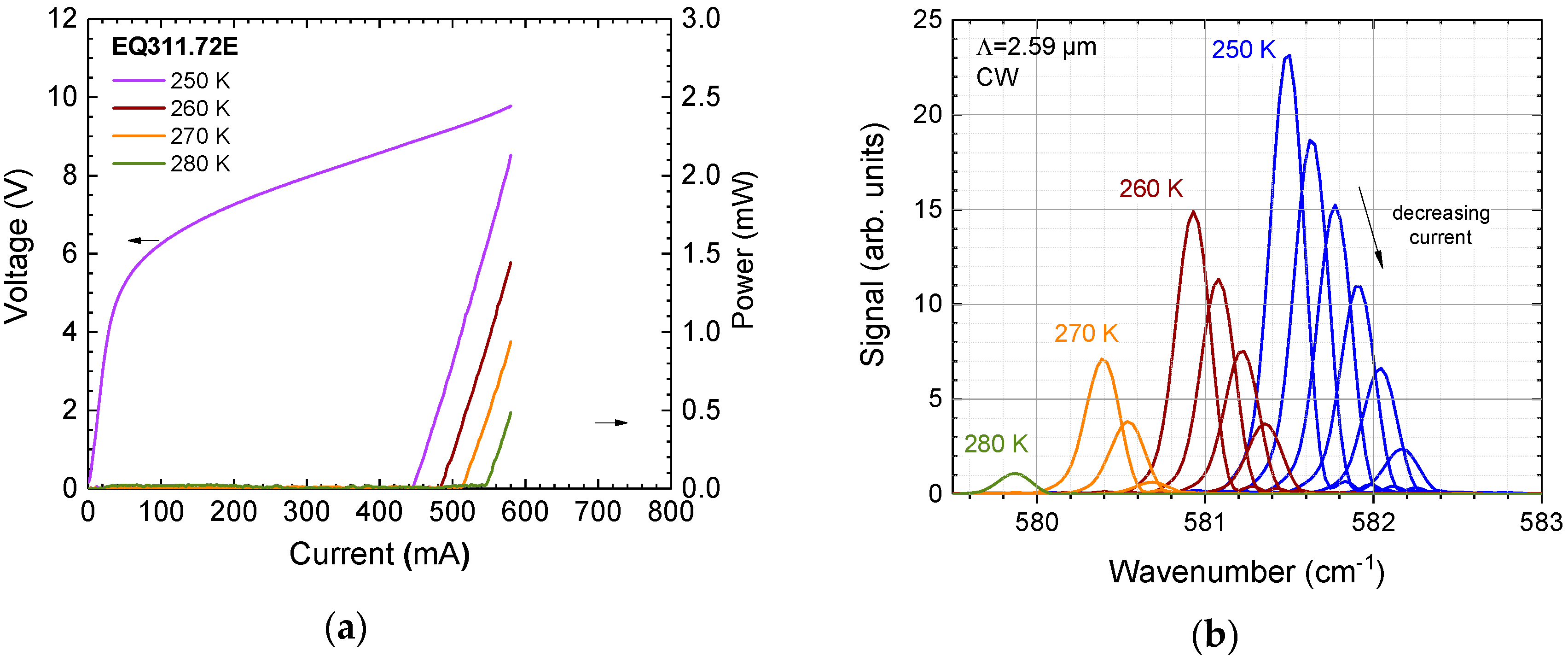
© 2019 by the authors. Licensee MDPI, Basel, Switzerland. This article is an open access article distributed under the terms and conditions of the Creative Commons Attribution (CC BY) license (http://creativecommons.org/licenses/by/4.0/).
Share and Cite
Nguyen Van, H.; Loghmari, Z.; Philip, H.; Bahriz, M.; Baranov, A.N.; Teissier, R. Long Wavelength (λ > 17 µm) Distributed Feedback Quantum Cascade Lasers Operating in a Continuous Wave at Room Temperature. Photonics 2019, 6, 31. https://doi.org/10.3390/photonics6010031
Nguyen Van H, Loghmari Z, Philip H, Bahriz M, Baranov AN, Teissier R. Long Wavelength (λ > 17 µm) Distributed Feedback Quantum Cascade Lasers Operating in a Continuous Wave at Room Temperature. Photonics. 2019; 6(1):31. https://doi.org/10.3390/photonics6010031
Chicago/Turabian StyleNguyen Van, Hoang, Zeineb Loghmari, Hadrien Philip, Michael Bahriz, Alexei N. Baranov, and Roland Teissier. 2019. "Long Wavelength (λ > 17 µm) Distributed Feedback Quantum Cascade Lasers Operating in a Continuous Wave at Room Temperature" Photonics 6, no. 1: 31. https://doi.org/10.3390/photonics6010031
APA StyleNguyen Van, H., Loghmari, Z., Philip, H., Bahriz, M., Baranov, A. N., & Teissier, R. (2019). Long Wavelength (λ > 17 µm) Distributed Feedback Quantum Cascade Lasers Operating in a Continuous Wave at Room Temperature. Photonics, 6(1), 31. https://doi.org/10.3390/photonics6010031



